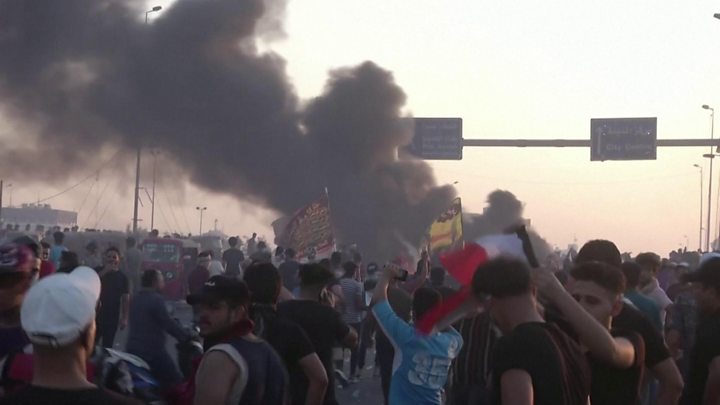Iraq protests: Death toll nears 100 as unrest enters fifth day
Anti-government rallies continue despite attempts to curb them with curfews and an internet blackout. …

 Image copyright AFP/Getty Images
Image copyright AFP/Getty Images The death toll from anti-government protests in Iraq has risen to almost 100, says the country’s parliamentary human rights commission.
The unrest entered its fifth day on Saturday, with at least five people killed in the latest clashes in the capital Baghdad.
The security forces are again reported to have used live rounds.
Demonstrators say they are taking a stand against unemployment, poor public services and corruption.
It is the deadliest unrest since so-called Islamic State was declared defeated in Iraq in 2017.
It is seen as the first major challenge to Prime Minister Adel Abdel Mahdi’s fragile government, nearly a year since he came to power.
The authorities have been trying to control the protests through curfews and a near-total internet blackout.
An emergency session of parliament failed to go ahead on Saturday afternoon.
What’s the latest?
The daytime curfew in Baghdad was lifted on Saturday, and smaller groups of protesters began to renew their action.
The city’s Tahrir Square has been the focal point of protests, but it was blocked on Saturday, according to local news agencies.
The violence has also affected majority Shia Muslim areas in the south, including Amara, Diwaniya and Hilla. A number of deaths were reported on Friday in the southern city of Nasiriya, about 320km (200 miles) away.
A total of 540 protesters have been arrested, of whom nearly 200 remain in custody, the human rights commission said.
It also said more than 3,000 people had been injured.
The demonstrators do not appear to have any clear leadership at the moment, and their anger in increasingly radicalising their demands, says the BBC’s Sebastian Usher.
Read more from Iraq:
What’s been the reaction?
On Friday, Prime Minister Mahdi vowed to respond to protesters’ concerns but warned there was no “magic solution” to Iraq’s problems.

Media playback is unsupported on your device
He said he had given his full backing to security forces, insisting they were abiding by “international standards” in dealing with protesters.
Iraq’s most senior Shia cleric, Ayatollah Ali al-Sistani, urged the government to respond to the demands for reform, saying it had “not answered the demands of the people to fight corruption or achieved anything on the ground”.
The UN and US have expressed concern over the violence, and urged the Iraqi authorities to exercise restraint.
Why is this happening now?
Corruption, unemployment and poor public services are at the heart of the discontent faced by young Iraqis today. The unrest began spontaneously with no formal leadership in mostly Shia areas in the south, and quickly spread.
Iraq has the world’s fourth-largest reserves of oil, but 22.5% of its population of 40 million were living on less than $1.90 (£1.53) a day in 2014, according to the World Bank. One in six households has experienced some form of food insecurity.
The unemployment rate was 7.9% last year, but among young people it was double that. And almost 17% of the economically active population is underemployed.
Unemployment in Iraq
Modelled ILO estimates, %
The country is also struggling to recover after a brutal war against the Islamic State group, which seized control of large swathes of the north and west in 2014.
Living conditions remain dire in many conflict-affected areas, with insufficient services.




